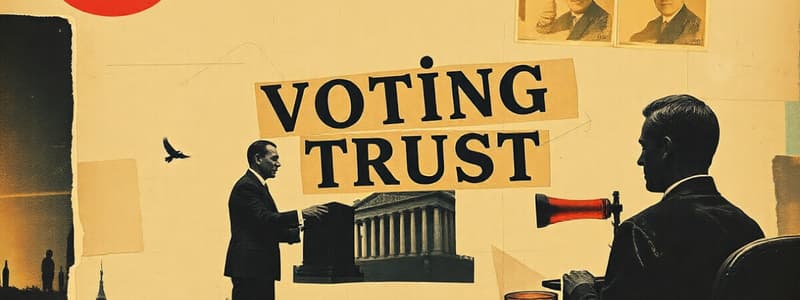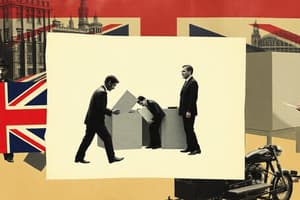Podcast
Questions and Answers
What is the primary reason financiers seek control through voting trusts?
What is the primary reason financiers seek control through voting trusts?
- To completely take over the corporation's operations
- To protect their investment until the corporation recovers (correct)
- To gain influence over corporate policy decisions
- To ensure immediate profits from investments
Who issues the voting trust certificate after shareholders deposit their shares?
Who issues the voting trust certificate after shareholders deposit their shares?
- The trustee, usually a trust company (correct)
- The shareholders themselves
- The corporation's Board of Directors
- The executive committee of the company
What authority do directors have in a corporation?
What authority do directors have in a corporation?
- Directors are responsible for auditing company finances.
- Directors can independently modify share prices.
- Directors provide day-to-day management of the company.
- Directors set company policies by passing resolutions. (correct)
Which of the following statements about board directors is NOT correct?
Which of the following statements about board directors is NOT correct?
What role does the trustee play in a voting trust agreement?
What role does the trustee play in a voting trust agreement?
What is a common characteristic of board committees like executive, finance, and audit committees?
What is a common characteristic of board committees like executive, finance, and audit committees?
What is the total depreciation charge reported using the straight-line method over the 8 years?
What is the total depreciation charge reported using the straight-line method over the 8 years?
Which year shows the largest decline in carrying amount in the declining-balance method?
Which year shows the largest decline in carrying amount in the declining-balance method?
How does depreciation affect a company's reported net income?
How does depreciation affect a company's reported net income?
What must be reviewed annually according to the IFRS accounting system?
What must be reviewed annually according to the IFRS accounting system?
What is the carrying amount at the end of Year 6 using the declining-balance method?
What is the carrying amount at the end of Year 6 using the declining-balance method?
Which of the following best describes the effect of depreciation on cash flow?
Which of the following best describes the effect of depreciation on cash flow?
What is the main purpose of depreciation in accounting?
What is the main purpose of depreciation in accounting?
Which statement regarding non-cash expenses is true?
Which statement regarding non-cash expenses is true?
What does the statement of changes in equity primarily record?
What does the statement of changes in equity primarily record?
How are retained earnings affected when dividends are declared?
How are retained earnings affected when dividends are declared?
What is depicted in the consolidated statement of changes in equity regarding non-controlling interests?
What is depicted in the consolidated statement of changes in equity regarding non-controlling interests?
What does total comprehensive income represent in relation to retained earnings?
What does total comprehensive income represent in relation to retained earnings?
In the provided example, what percentage of the subsidiary's total comprehensive income is attributable to the parent company?
In the provided example, what percentage of the subsidiary's total comprehensive income is attributable to the parent company?
What is the relationship between the statement of comprehensive income and the statement of changes in equity?
What is the relationship between the statement of comprehensive income and the statement of changes in equity?
What type of liabilities must a company settle within its normal operating cycle?
What type of liabilities must a company settle within its normal operating cycle?
Which of the following is NOT typically considered a current liability?
Which of the following is NOT typically considered a current liability?
Which financial document shows the difference between earned income and expenditures?
Which financial document shows the difference between earned income and expenditures?
Why is understanding a company's earnings power important when analyzing its financial condition?
Why is understanding a company's earnings power important when analyzing its financial condition?
Which of the following is specifically used to arrive at the tax amount owing for a period?
Which of the following is specifically used to arrive at the tax amount owing for a period?
What is indicated by a company’s ability to generate earnings and cash flow?
What is indicated by a company’s ability to generate earnings and cash flow?
Which type of current liability includes unpaid bills for raw materials and supplies?
Which type of current liability includes unpaid bills for raw materials and supplies?
When analyzing a company's debt ratios, which of the following types of liabilities are typically excluded?
When analyzing a company's debt ratios, which of the following types of liabilities are typically excluded?
Which part of the statement of comprehensive income reveals where earnings go?
Which part of the statement of comprehensive income reveals where earnings go?
What type of borrowing is typically categorized as a current liability?
What type of borrowing is typically categorized as a current liability?
Flashcards are hidden until you start studying
Study Notes
Voting Trust Agreement
- Voting control is transferred to a trustee to protect financier's investments while recovering the corporation.
- Shareholders deposit their shares with a trustee who issues a voting trust certificate, retaining voting privileges.
Corporate Structure
- Typical corporate hierarchy starts with Shareholders at the top, followed by the Board of Directors.
- The organizational chart includes the Chairman, President, Executive Vice President, and several Vice Presidents responsible for various functions like Finance, Marketing, and Human Resources.
Responsibilities of Directors
- Directors must meet age and sound mind requirements and cannot be undischarged bankrupts.
- Responsibilities include setting company policies, appointing officers, supervising banking authorities, and approving budgets for expansion.
Depreciation Methods
- Two common depreciation methods: Straight-Line and Declining-Balance.
- Straight-Line Method distributes equal depreciation charges over an asset's useful life.
- Declining-Balance Method allocates higher depreciation in the early years, reducing over time.
Statement of Comprehensive Income
- Reflects total earnings versus expenditures, determining profit or loss.
- Reveals sources of earnings, where earnings are allocated, and their sufficiency for operations.
- Total comprehensive income transitions to the statement of changes in equity.
Current Liabilities
- Current liabilities typically include debts that must be settled within one year.
- Common types: Current portion of long-term debt, near-term taxes payable, trade payables for raw materials, and short-term borrowings.
Retained Earnings
- Profits not distributed as dividends and reinvested in the business form retained earnings.
- Changes in retained earnings are affected by the current year’s comprehensive income and any dividends declared.
Statement of Changes in Equity
- Records shifts in equity components, including share capital and retained earnings.
- Connects the statement of comprehensive income to the statement of financial position.
Total Comprehensive Income
- Shows overall company earnings including those attributable to non-controlling interests.
- Total comprehensive income of the parent company includes subsidiaries profit contributions proportionate to ownership.
Financial Position Example
- Example of Trans-Canada Retail's consolidated statement shows total assets, property, plant, and equipment valued at $6,149,000, alongside other current and non-current assets.
Studying That Suits You
Use AI to generate personalized quizzes and flashcards to suit your learning preferences.




